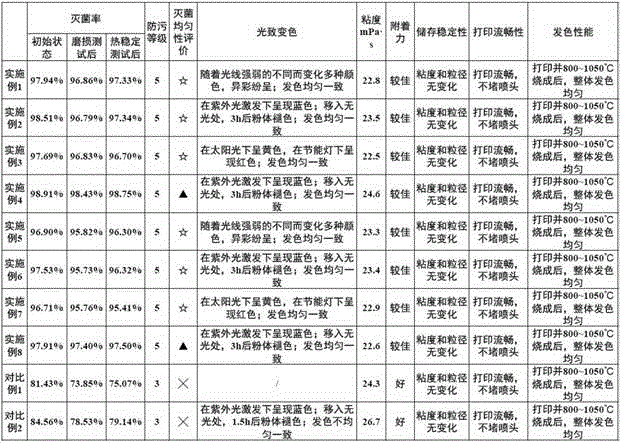Photochromic low-temperature ceramic ink for ink jetting and preparation method thereof
A technology of low-temperature ceramics and photochromism, which is applied in the field of ceramics and can solve the problems of high toxicity
- Summary
- Abstract
- Description
- Claims
- Application Information
AI Technical Summary
Problems solved by technology
Method used
Image
Examples
Embodiment 1
[0039] A photochromic low-temperature ceramic ink for inkjet and a preparation method thereof, the preparation method comprising the following steps:
[0040] Step A, mix 24% cobalt blue, 5% antibacterial compound, 10% photochromic compound, and 20% dry material of low-temperature frit, then pour it into a fast mixer and mix evenly; use a sand mill to grind for 10 hours, Make its particle size distribution ≤1μm;
[0041] Step B. Weigh 5% Tego710, 3.5% AEO-3, 0.2% Levaslip 8629, 0.4% BYK052, 0.8% polystyrene resin, 0.1% Disparlon NS-5501, 31% environmentally friendly hydrocarbon solvent, and then add the Disperse in a high-speed mixer for 30-60 minutes; put the dispersed mixture into a sand mill, and sand it for 10 hours to obtain a semi-finished ink with a particle size distribution of ≤300nm;
[0042] Step C, put the ink semi-finished product obtained in step B in a constant temperature mixing tank at 90°C, then vacuumize, vibrate at a high speed, and filter through a filter...
Embodiment 2
[0054] A photochromic low-temperature ceramic ink for inkjet and a preparation method thereof, the preparation method comprising the following steps:
[0055] Step A, mix 32% cobalt blue, 2% antibacterial compound, 5% photochromic compound, and 18% dry material of low-temperature frit, then pour it into a fast mixer and mix evenly; use a sand mill to grind for 10 hours, Make its particle size distribution ≤1μm;
[0056] Step B. Weigh 5% Tego710, 3.5% AEO-3, 0.2% Levaslip 8629, 0.4% BYK052, 0.8% polystyrene resin, 0.1% Disparlon NS-5501, 33% environmentally friendly hydrocarbon solvent, and then add the Disperse in a high-speed mixer for 30-60 minutes; put the dispersed mixture into a sand mill, and sand it for 10 hours to obtain a semi-finished ink with a particle size distribution of ≤300nm;
[0057] Step C, put the ink semi-finished product obtained in step B in a constant temperature mixing tank at 90°C, then vacuumize, vibrate at a high speed, and filter through a filter ...
Embodiment 3
[0069] A photochromic low-temperature ceramic ink for inkjet and a preparation method thereof, the preparation method comprising the following steps:
[0070] Step A, mix 38% cobalt blue, 0.5% antibacterial compound, 1% photochromic compound, and 15% dry material of low-temperature frit, then pour it into a fast mixer and mix evenly; use a sand mill to grind for 10 hours, Make its particle size distribution ≤1μm;
[0071] Step B. Weigh 5% Tego710, 3.5% AEO-3, 0.2% Levaslip 8629, 0.4% BYK052, 0.8% polystyrene resin, 0.1% Disparlon NS-5501, 36% environmentally friendly hydrocarbon solvent, and then add the Disperse in a high-speed mixer for 30-60 minutes; put the dispersed mixture into a sand mill, and sand it for 10 hours to obtain a semi-finished ink with a particle size distribution of ≤300nm;
[0072] Step C, put the ink semi-finished product obtained in step B in a constant temperature mixing tank at 90°C, then vacuumize, vibrate at a high speed, and filter through a filte...
PUM
| Property | Measurement | Unit |
|---|---|---|
| particle size | aaaaa | aaaaa |
Abstract
Description
Claims
Application Information
 Login to View More
Login to View More - R&D
- Intellectual Property
- Life Sciences
- Materials
- Tech Scout
- Unparalleled Data Quality
- Higher Quality Content
- 60% Fewer Hallucinations
Browse by: Latest US Patents, China's latest patents, Technical Efficacy Thesaurus, Application Domain, Technology Topic, Popular Technical Reports.
© 2025 PatSnap. All rights reserved.Legal|Privacy policy|Modern Slavery Act Transparency Statement|Sitemap|About US| Contact US: help@patsnap.com

